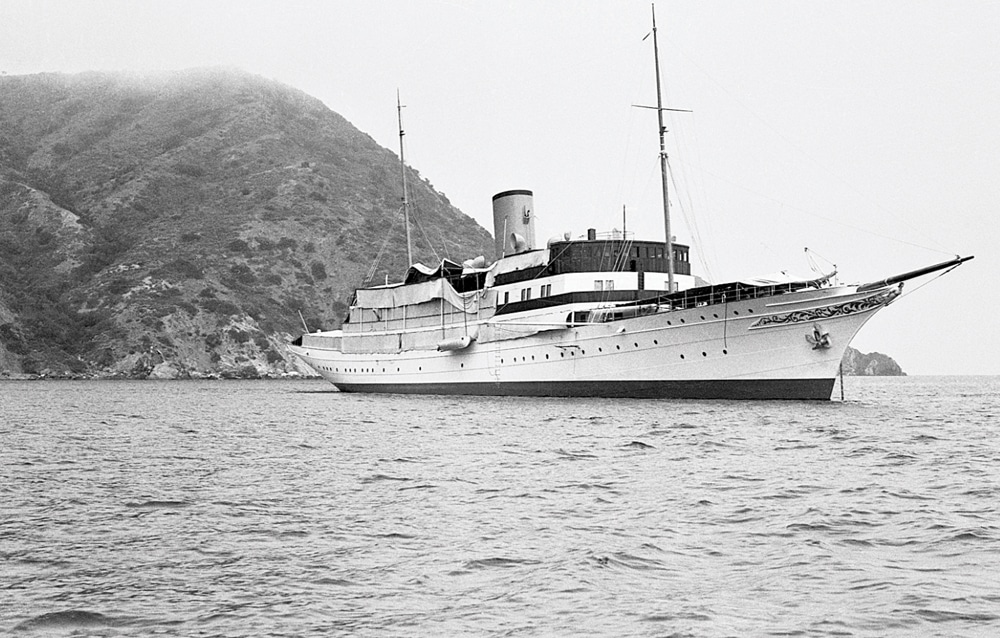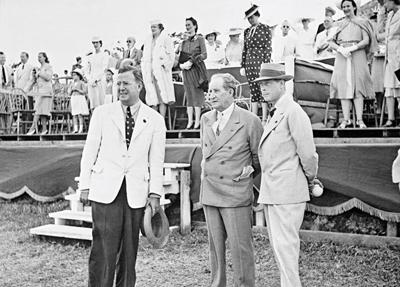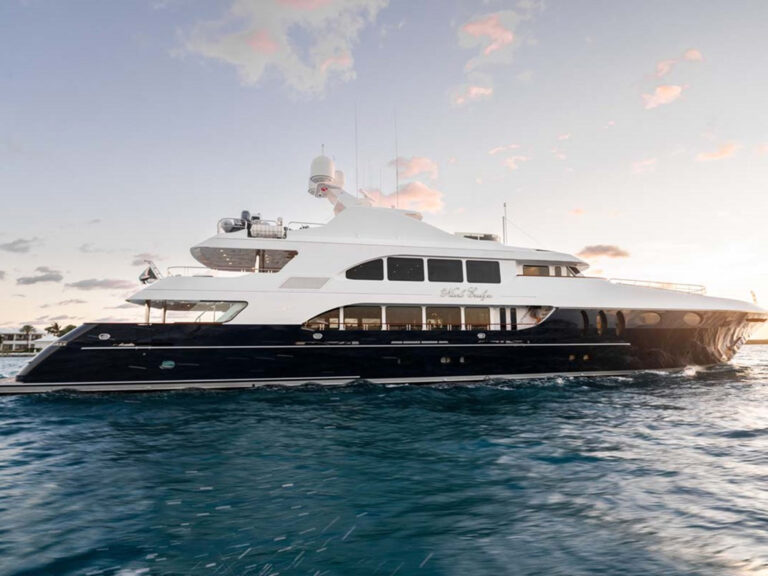
3-Way Nassau
Imagine three men conversing in the salon of a 320-foot yacht anchored in the Bahamas. Beyond the opulent cabin, war rages and England and the United States are allied against a common enemy. One of the three, a wealthy industrialist, is suspected of being an enemy agent, the second is a member of the British royal family and may be a traitor, and the third, a self-made man who struck gold, will soon be murdered and his killers never caught.
This fictional story reads like a Hollywood screenplay, a bad thriller consigned to the rejection heap. But go back to 1942, and you will find this precise scenario.
As war broke out in Europe, Swedish industrialist Axel Wenner-Gren sailed to Bahamian waters aboard Southern Cross, one of the largest private motoryachts in the world. Wenner- Gren’s tenure in the Bahamas mixed business and pleasure: Among his offshore properties was Paradise Island off Nassau, the site of today’s Atlantis mega resort and marina.
While you might think that the Bahamas were the farthest place in the world from the mayhem of war, during 1942 and 1943 a critical phase of the Battle of the Atlantic was playing out all around the islands. Predatory U-boats were lying in wait for the oil tankers from Venezuela and the Gulf of Mexico as they tried to make their way north along the Gulf Stream. German successes were staggering. In just June and July 1942, 30 ships were sunk along the southern edge of Bahamian waters. By November U-boats had sunk 263 ships in the Caribbean Sea alone. Britain’s wartime leader Winston Churchill was apoplectic, and he wrote President Franklin Delano Roosevelt begging for more aggressive action by the U.S. Navy. German submarines were dangerously close to forcing Britain’s capitulation. It was all about oil.

Allied intelligence agencies mistrusted Axel Wenner-Gren immensely. The Swede made his fortune as founder of the Electrolux vacuum cleaner company, but he was also a major owner of Bofors, the Swedish armaments manufacturer that had covertly assisted in Germany’s rearmament under the Nazi regime.
Wenner-Gren was heard to boast about his friendly connections to Hitler’s inner circle, and his crew was formerly of the Swedish Navy, considered a pro-German organization within neutral Sweden. Southern Cross herself had immense fuel capacity and bristled with antennas connected to its state-of-the- art radio room. Wenner-Gren had purchased Southern Cross from American tycoon Howard Hughes for $1 million. “The Aviator” was courting the women of Hollywood in the 1930s and had entertained them aboard the palatial vessel.
Events of September 1939 went a long way to fuel Allied suspicions about the Swede. This was before Wenner-Gren’s arrival in the Bahamas and happened while Southern Cross was on a pleasure cruise in the North Atlantic. In the first sinking of the submarine war, German sub U-30 torpedoed the liner Athenia with 1,450 Canadian and American passengers on board. Along came Southern Cross, which happened to be nearby. She picked up 200 survivors and delivered them to Ireland.
Move forward to 1942. Allied intelligence suspected that even if Wenner-Gren hadn’t come to the Bahamas on a secret mission to refuel German submarines, Southern Cross may have very well been serving as a scout ship, helping U-boats find targets such as Athenia.
Despite official paranoia, Wenner-Gren was able to take up residence in the Bahamas. He became friendly with the Duke of Windsor, who had come to Nassau to serve as wartime governor of the Bahamas, then a British possession. The duke used to be Edward VIII, King of England. In a spectacular 1936 news event, he had abdicated the throne of England to marry the “woman I love,” an American divorcée named Wallis Simpson. The abdication twosome were frequent guests aboard Southern Cross, and Wenner-Gren once loaned the use of his yacht to run Simpson over to Florida to have a tooth pulled.
Before the war, the duke and his wife had met Hitler and expressed their admiration for the Nazi regime. It is widely suspected that Windsor later engaged in treasonous wartime communications with the Nazis, any evidence of which will remain under the seal of British government secrecy until 2046. He was believed to be Hitler’s first choice to be puppet ruler of Britain after the planned German invasion. Churchill, in effect, had exiled the duke to Nassau to get this troublesome royal out of the way.
Another friend of Wenner-Gren was Sir Harry Oakes, one of the wealthiest men in the British empire. A native of Maine’s Down East region, Oakes amassed an enormous fortune by discovering gold in Canada. He became a Canadian citizen and eventually landed in Nassau, where he was knighted for his good works in the community.

While Wenner-Gren was on a cruise to Mexico, the Allies blacklisted him, forcing the Swede to remain there with his famous yacht. Despite this exile, the duke and Oakes are suspected of having struck long-distance financial deals involving good friend Wenner-Gren — illegally. These investments would have been in contravention of wartime monetary regulations and, given Wenner-Gren’s involvement, possibly designed to expand Nazi influence in Latin America. Or at least that’s how Allied higher-ups would view it. As German bombs fell on London, one can only imagine how angry this knowledge might have made Churchill and the hard men of his intelligence services.
When Sir Harry Oakes’ body was found bludgeoned and burned in July 1943, the Duke of Windsor did something very odd. Instead of summoning Scotland Yard to the colony, he forbade anyone but two handpicked, mediocre Miami police detectives from investigating the case. One explanation was that the duke feared that a competent investigation might reveal his own shady dealings with Wenner-Gren.
These detectives arrested Oakes’ son-in-law, a dashing French marquis named Alfred de Marigny, on evidence so flimsy it was nearly invisible. De Marigny, though quickly acquitted of the gruesome slaying, was nevertheless asked to leave the Bahamas. He went to stay for a short period at the home of his friend Ernest Hemingway, just outside of Havana, Cuba. Coincidentally the novelist happened at that time to be working as a freelance agent for U.S. Naval Intelligence at the Havana embassy.
Who killed Harry Oakes? Books have been written on the subject, pointing the finger at the American Mafia, which wanted to develop casinos in Nassau, or Allied intelligence services, or a combination of both. Another scenario blames the scion of a Bahamian real estate brokerage that remains prominent to this day. Secret documents surrounding the relationship between the Duke of Windsor and the Nazis may hold some answers, but secrecy fuels speculation and the Web spreads it. Some have even wondered whether Wenner-Gren himself may have been involved in the killing, though that would seem out of character for the affable industrialist.
Wenner-Gren remained in Mexico for the duration of the war, donating_ Southern Cross_ to the Mexican Navy for use as a training vessel. (One account has the ship being scrapped in 1960.) Wenner-Gren’s business dealings in Latin America accrued even more wealth for him, not the least of which was founding what became Mexico’s telephone monopoly.
After the war, Wenner-Gren returned to the Bahamas and, among other things, bought up property on the island of Andros. Friends and surrogates minimized the Swede’s connection to the Nazis, saying Wenner-Gren himself had exaggerated his relationship with men such as Air Marshal Hermann Goering. In that, Wenner-Gren joined the legion of powerful people then trying to distance themselves from the Nazis, who were not only defeated but by then had been revealed to be mass murderers.
Wenner-Gren died in 1961 and, aside from never-proven wartime suspicions, is remembered through the foundations that bear his name. One of the Swedish magnate’s good works, the Wenner-Gren Foundation, continues to be a prominent supporter of worldwide research in “all branches of anthropology.”
After the Bahamas, the Duke of Windsor was never given another official role. He and Wallis quietly lived out their lives unloved by anyone but each other.
As accusations go unproven and crimes remain unsolved, the tales of Wenner-Gren, Windsor and Oakes continue to intrigue. And as documents are unsealed and loyalties revealed, perhaps a realistic thread of the tale will emerge to suit Hollywood’s needs, and the story will come to life on the big screen. Until then, it’s just too far-fetched.
For more on intrigue in the Bahamas, look for the following books: Who Killed Sir Harry Oakes? by James Leasor (House of Stratus, 1983); The Secret History of the FBI by Ronald Kessler (St. Martins Press, 2002); and Operation Drumbeat: The Dramatic True Story of Germany’s First U-Boat Attacks Along the American Coast in World War II by Michael Gannon (Harper and Row, 1992)









